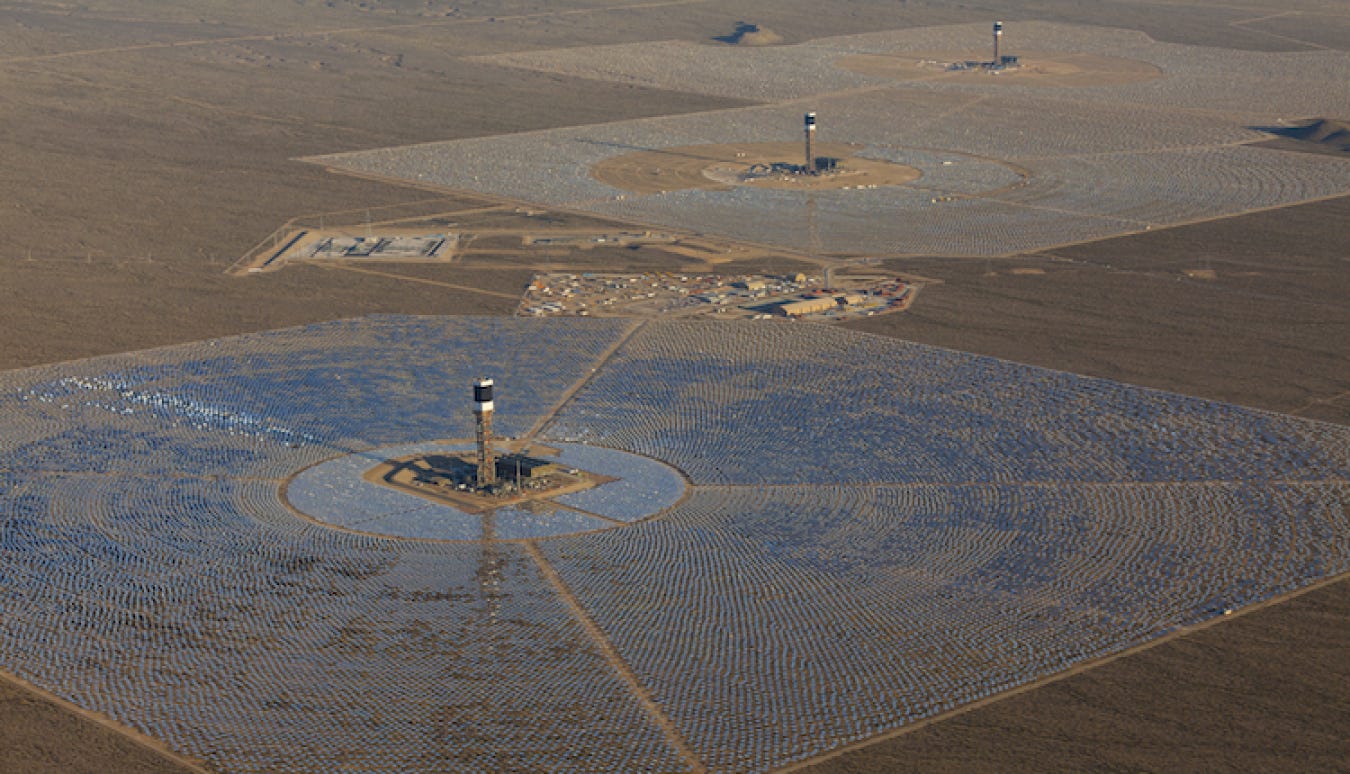
STATE — One of the largest thermal-solar plants in the country is expected to shut down most operations in 2026 due to cost and other factors, according to reports.
The Ivanpah Solar Power Facility, which resides on Interstate 15 at the California-Nevada border in the Mojave Desert, started operations in January 2014, but Pacific Gas & Electric announced it will no longer purchase power from the 386-megawatt facility. The plant is operated by NRG Energy, which owns the gas peaker plant in Carlsbad, acknowledged in a statement the solar facility cannot compete with rooftop solar, while others said other issues include obsolete technology and the plant never generating more than 75% of its planned output in a year.
The California Public Utilities Commission must approve the power purchase agreement termination. If approved, PG&E will exit in January 2026.
The facility received a $1.6 billion loan guarantee from the U.S. Department of Energy with a total cost of $2.2 billion, the Las Vegas Review Journal reported. PG&E’s agreement is with Solar Partners, which consists of NRG, Google and Kelvin Energy. NRG invested $300 million, Google $168 million and the rest was covered by BrightSource (now Kelvin Energy).
“Ivanpah proved to be a successful demonstration of CSP technology, however, it has been surpassed by solar photovoltaics (PV) due to much lower capital and operating costs in producing clean energy,” NRG said in its statement. “In accordance with regulatory requirements, in 2023 PG&E sought proposals for restructuring or terminating its renewable PPAs to reduce the cost to its customers. On Jan. 14, 2025, Ivanpah’s owners and the DOE (U.S. Department of Energy) finalized negotiations with PG&E to terminate their two long-term purchase power agreements, allowing the DOE to maximize the recovery of its loans and provide savings for California ratepayers.”
Two of the three towers are planned to cease operations, NRG said. Southern California Edison, the other utility with a purchase power agreement with the facility, is not covered under the agreement.
The plant was envisioned as a pathway to bring cheaper renewable energy to customers through its concentrating solar power (CSP), also known as solar-thermal, technology. The plant covers about five square miles and uses nearly 350,000 computer-controlled mirror the size of a garage door to reflect sunlight to three 459-foot boilers, according to the Associate Press.
The boilers heat water in the tubes to generate steam, which drives the turbine to create electricity.

According to NRG, the plant sold about two-thirds of its power to PG&E and the remaining to Southern California Edison. However, media reports showed the cost of the solar power is about five times higher than market rate, which is passed through to ratepayers. The purchase power agreements were through 2039.
The facility is also under financial pressure as it was constructed from grants from the DOE, although the money has not been repaid, E&E News reported, which covers energy and the environment.
Benjamin Zycher, a senior fellow at the American Enterprise Institute, ripped the financial troubles noting the owners of the plant also applied and received a $533 million grant from Treasury Department to pay back part of the loan guaranteed at no charge by the DOE. Also, the owners received a 30% investment tax credit and a depreciation bonus of 50% in its first year, he wrote.
“And there is the guaranteed market share for wind and solar power — the ‘renewable portfolio standard’ — which meant that the major California utilities were forced to buy the power produced by Ivanpah,” Zycher added. “Performance has proven so poor that PG&E has exercised its right to terminate the contract, about which negotiations have been completed; there is no doubt that towers 1 and 3 will cease operations within roughly a year. And it appears to be the case that Edison too wants out: ‘the utility is in ‘ongoing discussions’ with the project’s owners and the federal government over ending the utility’s contract.”
In addition, the plant has been under fire since its opening for killing thousands of birds each year.
According to reports, birds that fly over the farm die instantly from the rapid increase in temperature from the mirrors. E&E report at least 6,000 birds die each year from flying into concentrated beams of sunlight.
“Along with killing thousands of birds and tortoises, the project’s construction destroyed irreplaceable pristine desert habitat along with numerous rare plant species,” Julia Dowell of the Sierra Club told the AP. “While the Sierra Club strongly supports innovative clean energy solutions and recognizes the urgent need to transition away from fossil fuels, Ivanpah demonstrated that not all renewable technologies are created equal.”
The California Legislative Analyst’s Office reported earlier this year the state’s electricity prices are double the U.S. average, second only to Hawaii. A recent University of Chicago study reveals the hidden costs of solar and wind.
According to the study, direct generation costs have decreased, but the unreliability requires expensive backup systems, such as batteries or natural gas power plants. The study factors storage and backup needs, which spikes solar prices to $1,548 per megawatt-hour and $504 for wind.
Grid Brief reported renewable mandates have resulted in an average 11% increase in electricity prices from 1990-2015.
Follow North County Pipeline on Instagram, Facebook, X and Reddit. Send story ideas and tips to ncpipeline760@gmail.com.











